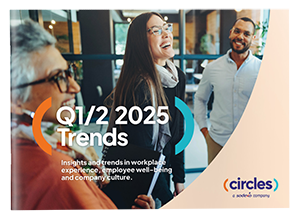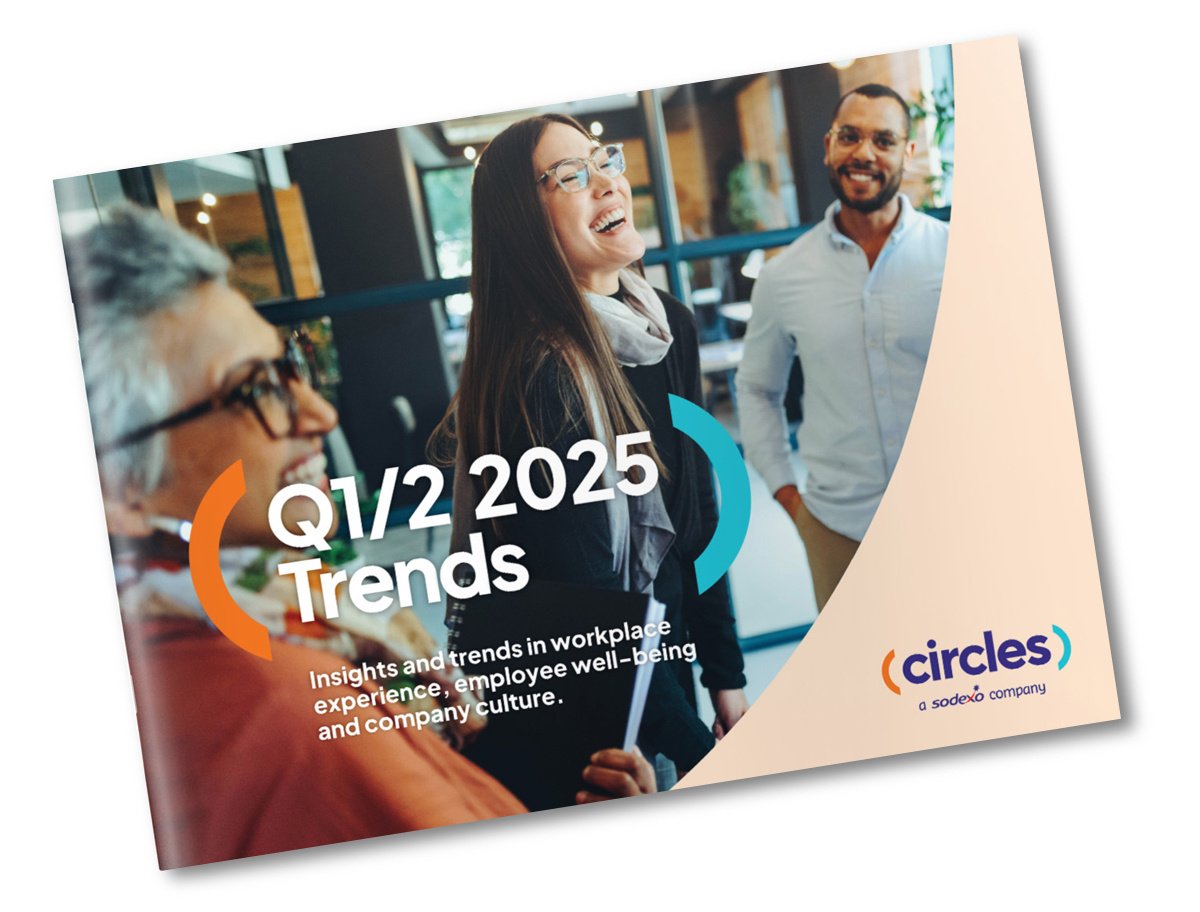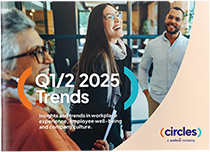
Complimentary Q1/2 Report
2025 Workplace Trends Report
Focusing on workplace experience, employee well-being and company culture
Uncover the newest workplace trends essential for business leaders, facilities and real estate managers, and HR practitioners:

-
Address six key workplace experience challenges
-
Build a human-focused workplace by fostering connection, embracing flexible work arrangements and building trust
-
Discover how return to office (RTO) mandates are affecting company culture, the employee experience, business operations and the local community
-
Learn 11 workplace trends we’re seeing as organizations navigate RTO challenges
-
Get top employee engagement trends including the importance of prioritizing people and how to use culture to improve employee well-being
and more!
Here's a preview of what's inside: Trend #1 on Workplace Experience

Creating memorable experiences in the workplace
Workplaces are no longer just locations where tasks are completed — they reflect an organization’s culture, values, and aspirations.
Meaningful workplace experiences drive success by enhancing engagement, attracting top talent, and fostering creativity, while failure to prioritize the everyday experience of employees can stifle innovation and retention.
Employees who feel valued and inspired become brand advocates, strengthening a company’s reputation and fueling growth. Additionally, a workplace that values meaning and purpose is a fertile ground for creativity, leading to innovation and growth as employees are inspired to bring new ideas and solutions to the table.
The reality of RTO
However, return-to-office (RTO) trends are challenging these advantages. Currently, 33% of U.S. employers require full-time in-office work and the number is expected to rise slightly in 2025 but not exceed 50%, according to Rob Sadow, CEO and co-founder of research platform Flex Index, which has been tracking remote work policies since early 2023. Companies like Amazon, Dell, and Goldman Sachs face resistance to RTO mandates, with employees quitting or turning to “coffee-badging” to maintain remote flexibility. To thrive, organizations must blend the flexibility of remote work with the innovation sparked by in-person collaboration.
Key workplace experience challenges in 2025
In addition to RTO, employers are navigating a host of other factors that contribute to the quality of the workplace experience. Many of the top challenges in 2025 will be familiar, as they have been growing for some time, making it critical to adopt effective solutions sooner rather than later. Here are five we see trending:

1) Adapting to the normalization of remote and hybrid work models
This challenge remains distinct, as it focuses on the evolution of work structures and how organizations can foster collaboration, productivity, and engagement in remote and hybrid environments.

2) Addressing mental health and wellness among employees
Prioritizing mental health and overall wellness is essential, especially as employees navigate increasing stressors both in and outside the workplace. This includes offering support through resources, flexibility, and creating a culture that promotes well-being.

3) Managing workforce diversity and inclusion in a global context
As the workforce becomes more diverse and global, creating inclusive environments must also address diversity in physical spaces. Organizations need to ensure policies are culturally appropriate, equitable and delivered in an environment that respects and values differences.

4) Navigating the rapid pace of technological advancements and automation
With the accelerating pace of technological change, HR leaders must stay ahead of trends in automation and AI to ensure workforce readiness and maintain alignment with future business needs while continuing to provide convenience for employees.

5) Ensuring environmental sustainability and corporate responsibility
As social impact becomes a core value for more employees, organizations must align their practices and workspaces with environmental goals, while also meeting broader corporate responsibility standards.
Get the full 46-page 2025 Workplace Trends Report

Top workplace experience trends
To successfully move the needle on workplace experience early in 2025, leaders will need to take actions that address multiple challenges simultaneously. An effective approach requires creativity, flexibility, and innovative strategies and policies to create a positive and adaptable workplace environment that promotes positive experiences.
Enhancing the employee experience has become a priority for leaders across the entire organization — from facilities management to heads of workplace experience to operations to IT and beyond. Gartner reported that 47% of HR leaders see employee experience as paramount and that it has a “very positive impact” on return on investment. Research from the International Facility Management Association (IMFA) validates that the focus of facility management on enhancing both efficiency and occupant satisfaction underscores the importance of a positive workplace environment.
Here's what we see trending:
Personalizing the workplace environment
To boost employee engagement and enhance well-being, employers are increasingly personalizing workplace environments to cater to individual preferences. Driven by data collection and feedback, this customization can influence factors such as lighting, temperature, and ergonomic setups. When employees feel their needs are met, they are more likely
to be engaged and perform at higher levels.
Building culture beyond the office
Organizations are increasingly extending their cultural values into external community initiatives. Volunteer programs, local partnerships, and team service days create opportunities for employees to connect with the local community in which they work, while supporting the company’s social impact goals. These initiatives not only build stronger teams but also foster
a sense of purpose and belonging.
Maximizing workspace usage
In today’s cost-conscious and flexible work environment, organizations are increasingly leveraging underused spaces to maximize the value of their real estate investments. Areas infrequently used such as lobbies, courtyards and meeting rooms are being transformed into vibrant zones that can accommodate a variety of activities. This enhances space efficiency, reduces overhead costs and allows for a more agile, adaptable workplace that meets evolving business needs.
Delivering a brand experience
As organizations navigate a competitive landscape, they’re finding a strong brand can be a significant differentiator in attracting talent and enhancing the company’s reputation. Companies are extending their brand into the workplace environment to consistently deliver a cohesive experience that satisfies everyone visiting their offices — employees, clients and guests alike. This positive experience forms lasting impressions that validate the brand and lends credibility to the organization.
Managing the employee journey
Modern employers understand that every touchpoint in the employee lifecycle matters. From the initial application process to the exit interview, the entire employee journey offers an abundance of opportunities for engagement. By reimagining this journey, HR leaders can strengthen loyalty and improve retention.
Creating a data-informed employee experience
In order to implement more meaningful workplace improvements, business leaders tasked with improving the employee experience are using data to uncover pain points and identify strengths. Whether through feedback or predictive analytics, this approach ensures workplace experience strategies from both HR and real estate perspectives are aligned — and stay aligned — with
employee expectations and needs.
Using AI to shape HR
AI tools such as ChatGPT-style assistants are revolutionizing HR processes by offering employees immediate access to comprehensive information. For instance, an employee seeking maternity leave guidance can receive tailored resources covering FMLA, fertility benefits, and emotional support programs in one query, ensuring clarity and efficiency.
Championing diversity and inclusion
Understanding the profound significance of diversity and inclusion, Lockton’s Trends of the 2024 Workplace reports that organizations are incorporating diverse hiring panels and blind recruitment. Regular diversity training for all employees and leaders is becoming a modern workplace “must-have.” By fostering an inclusive workplace culture, businesses not only set themselves apart but also create a positive resonance with the local workforce.
Aligning the employee experience with ESG goals
Sustainability and corporate responsibility are becoming cornerstones of workplace culture. Initiatives such as bike-to-work programs, eco-friendly office supplies, and green certifications resonate deeply with employees, particularly younger generations who prioritize environmental stewardship. Organizations who partner with local businesses and host community events are contributing to positive social impact.
Download the full 2025 Workplace Trends Report

Charting the path forward: owning the workplace experience
The question of how to continuously motivate, engage, and retain talent isn’t just a philosophical challenge — it’s a call to action.
Creating meaningful workplace experiences starts with leaders taking ownership of the journey. By delivering brand experiences, leveraging technology, and personalizing the workplace environment, organizations can build a culture where employees feel valued, supported, and inspired to contribute their best.
The memorable workplace of tomorrow is one that listens, learns, and evolves with its people. Whether through personalization, diversity champions or aligning with environmental, social, and governance (ESG) goals, the strategies outlined here offer a roadmap to not just retain talent but to help employees thrive. The responsibility lies with leaders to ensure the workplace experience is not an afterthought, but a deliberate and dynamic part of organizational success.
By embracing this mindset, organizations can build a workplace that doesn’t just meet today’s challenges but shapes the future of work.
Get the full Workplace Trends Report

